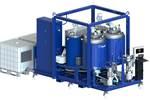Covestro incorporates thermoplastic composites into sports shoe
Covestro collaborated with global sportswear company Anta Sports Products to incorporate a carbon fiber shank to improve the torsional stiffness of a KT6 basketball shoe.

The KT6 basketball shoe from Anta Sports Products is equipped with a shank made of Maezio composite materials from Covestro. Photo Credit: Covestro
Anta Sports Products Ltd. (Xiamen, China), a global sportswear company, has recently launched KT6, the latest generation of the signature sneaker of NBA all-star Klay Thompson. Available for sale in China and some Southeast Asian countries, the basketball shoe features a variety of material technologies, including a carbon fiber shank made with Covestro AG’s (Leverkusen, Germany) Maezio thermoplastic composites for midfoot support and a smooth transition from heel to toe.
According to Covestro, Maezio is a brand of continuous fiber-reinforced thermoplastic composites that enable high-performance components for the footwear industry, among many other applications. The strong and lightweight materials are said to provide superior stiffness without adding much weight to shoe parts, such as the midsole (a layer of leather or rubber between the insole and the outsole of a shoe), toe kick and shank, a supporting structure in the shoe that runs beneath the arch of the foot.
“The excellent properties of carbon fiber composites can significantly improve the torsional stiffness of basketball shoes and help smooth the transition from heel to toe,” says Anson Zheng, senior director of Anta’s basketball category and designer of KT6. “The carbon fiber shank, together with the highly responsive midsole and shock-absorbing module on the heel, makes the KT6 a truly high-performance kick on the court.”
Out of the six KT generations Anta has released in this line, the KT6’s X-shaped shank was required to be very thin to meet the weight specifications, but also strong enough to fulfill the torsional requirements. Maezio composites offered not only stiffness at low density, but also a great deal of design freedom — Covestro notes that it can be stacked layer by layer at different angles to form sheets that are tailored to specific performance and mechanical criteria. For the design of the Anta shank, the orientation of the carbon fiber has been optimized to provide high stability, while the thickness is limited to one millimeter to achieve a lightweight feel.
Further, Maezio composites were said to be chosen for its efficiency to process on a large scale; the materials can be thermoformed efficiently at high yield rates and low cycle times. Further, the recyclability aspect is said to offer added value for footwear brands that want to focus more on sustainability.
Covestro says it has collaborated with Anta prior to the KT6, supporting the sporting goods company in the design of carbon fiber midsoles for another basketball shoe and a running shoe.
“We’re excited to support Anta in the design and development of its brand-new athletic shoes by contributing our material expertise in composites,” says Lisa Ketelsen, head of the thermoplastic composites business of Covestro. “We see Maezio as a material that enables efficient mass production of high-performance parts in a diverse range of applications, including footwear. Another advantage is that the material can be adapted to the desired performance and different production sizes, and offers great value creation across industries.”
Related Content
-
Infinite Composites: Type V tanks for space, hydrogen, automotive and more
After a decade of proving its linerless, weight-saving composite tanks with NASA and more than 30 aerospace companies, this CryoSphere pioneer is scaling for growth in commercial space and sustainable transportation on Earth.
-
Plant tour: Joby Aviation, Marina, Calif., U.S.
As the advanced air mobility market begins to take shape, market leader Joby Aviation works to industrialize composites manufacturing for its first-generation, composites-intensive, all-electric air taxi.
-
Plant tour: Albany Engineered Composites, Rochester, N.H., U.S.
Efficient, high-quality, well-controlled composites manufacturing at volume is the mantra for this 3D weaving specialist.















